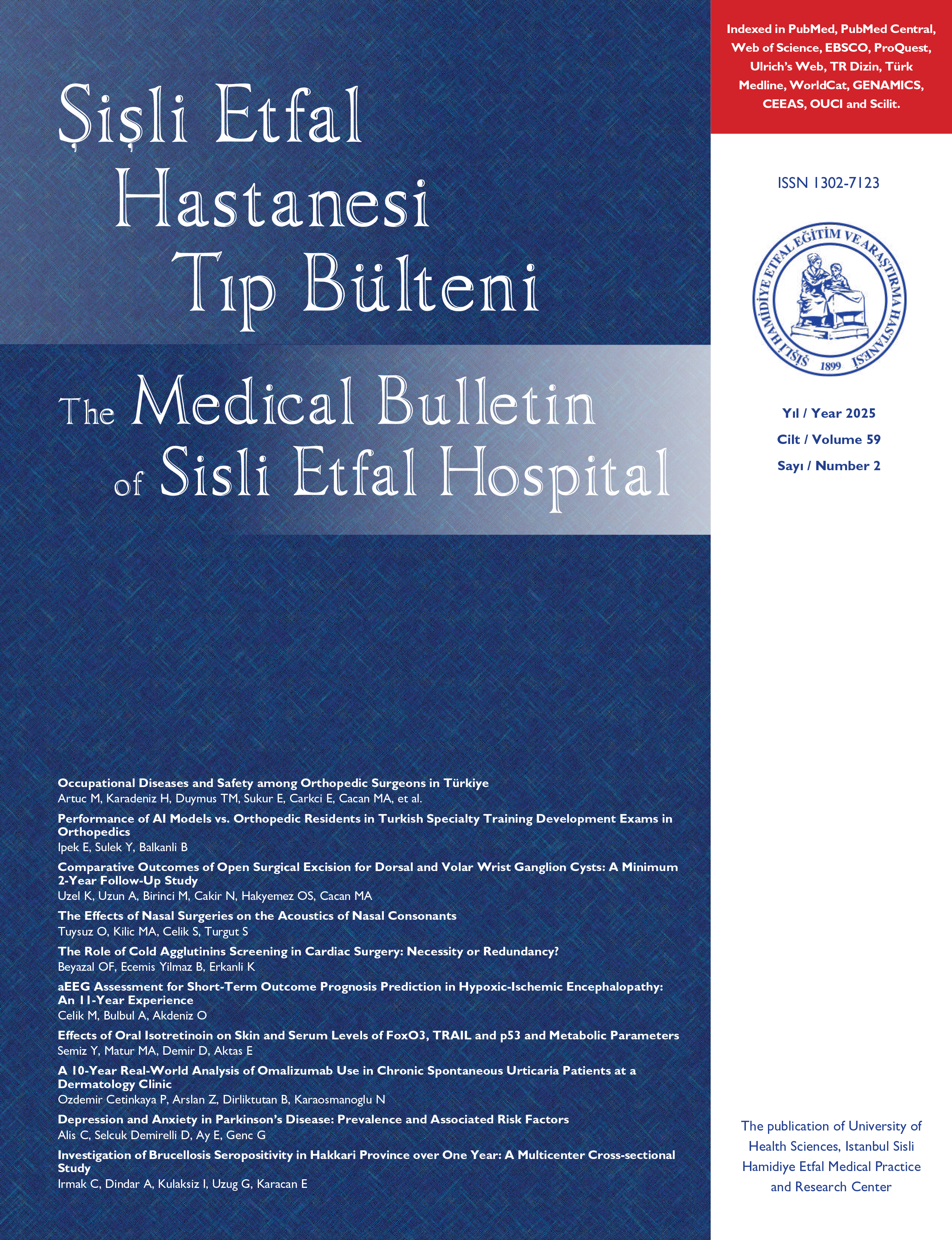
Demir Eksikliği Çocuklarda İnguinal Herni Gelişimi İçin Risk Faktörü Olabilir
Birsen Harma1, Tugba Raika Kiran2, Feyza Inceoglu31Malatya Turgut Özal Üniversitesi, Çocuk Cerrahisi Anabilim Dalı, Pediatrik Yanık Ünitesi, Malatya2Malatya Turgut Özal Üniversitesi, Biyokimya Anabilim Dalı, Malatya
3Malatya Turgut Özal Üniversitesi, Tıp Fakültesi, Biyoistatistik Anabilim Dalı, Malatya
Amaç:
Bu çalışmada, inguinal herni tanısı ile ameliyat edilen pediatrik hastaların rutin hemogram ve biyokimyasal parametrelerinin etyopatogenez ile ilişkisi araştırıldı.
Gereç ve Yöntem
Ocak 2019-Kasım 2022 tarihleri arasında inguinal herni nedeniyle opera edilen seksen olgu çalışmaya dahil edildi. Hastane kayıtları kullanılarak, bilinen herhangi bir hematolojik veya metabolik hastalık öyküsü veya düzenli ilaç kullanımı olmayan seksen pediatrik hasta ile de bir kontrol grubu oluşturuldu. Her iki grupta da hemoglobin (Hgb), hematokrit (Htc), ortalama korpusküler hacim (MCV), ortalama korpusküler hemoglobin (MCH), ortalama korpusküler hemoglobin konsantrasyonu (MCHC), eritrosit dağılım genişliği (RDW) ve trombosit (PLT)
değerlerini karşılaştırmak için istatistiksel analiz yapıldı.
Bulgular
Çocuk hastaların yaş aralığı 1-14 yıl idi. Seksen çocuğun 47'si (%58,8) erkek, 33'ü (%41,3) kadındı ve yaş ortalaması 5,79 ± 3,26 saptandı. İn guinal herni hastalarında Hgb, Htc, MCH, MCHC ve MCV değerleri kontrol grubundakilere göre istatistiksel olarak anlamlı derecede
düşük (p<0.05) ve RDW değerleri ise anlamlı derecede yüksek bulundu (p<0.05).
Sonuç
Kontrol grubu ile karşılaştırıldığında, M CH, MCHC, MCV, Hgb, HTC değerlerinde gözlenen azalma ve hasta grubunda RDW'deki artış, demir eksikliğinin muhtemel etkisini düşündürmektedir. Bu spesifik değişiklikler, demir eksikliğinin kollajen yapısında yapısal değişikliklere yol açarak çocukluk çağındaki inguinal hernilerin etyopatogenezine katkıda bulunabileceğini düşündürmektedir. (SETB-2023-01-013)
Iron Deficiency may be a Risk Factor for Inguinal Hernia Development in Children
Birsen Harma1, Tugba Raika Kiran2, Feyza Inceoglu31Department of Pediatric Surgery, Pediatric Burn Unit, Malatya Turgut Ozal University, Malatya, Türkiye2Department of Biochemistry, Malatya Turgut Ozal University, Malatya, Türkiye
3Department of Biostatistics, Faculty of Medicine, Malatya Turgut Ozal University, Malatya, Türkiye
Objectives: This case control study aimed to investigate whether the routine hemogram and biochemical parameters of pediatric patients who have undergone surgery for inguinal hernia are associated with the etiopathogenesis of the disease.
Methods: Eighty cases of inguinal hernia surgery performed between January 2019 and November 2022 were included in the study. A control group was also established using hospital records, consisting of eighty pediatric patients without any known history of hematological or metabolic disease or use of regular medication. Statistical analysis was conducted to compare the total hemoglobin (Hgb), hematocrit (Htc), mean corpuscular volume (MCV), mean corpuscular hemoglobin (MCH), mean corpuscular hemoglobin concentration (MCHC), erythrocyte distribution width (RDW) and thrombocyte (PLT) values in both groups.
Results: The age range of the pediatric patients was 1-14 years. Of the eighty children, 47 (58.8%) were male and 33 (41.3%) were female, with a mean age of 5.79±3.26. The values of Hgb, Htc, MCH, MCHC, and MCV in the inguinal hernia patients were found to be statistically significantly lower than those in the control group (p<0.05). Additionally, the patient RDW values were found to be statistically significantly higher than those in the control group (p<0.05).
Conclusion: Compared to the control group, the observed decrease in MCH, MCHC, MCV, Hgb, HTC values, as well as the increase in RDW in patient group, suggests a predisposing effect of iron deficiency. These specific changes suggested that iron deficiency may lead structural changes in the collagen construction and may contribute the etiopathogenesis of childhood inguinal hernia.
Makale Dili: İngilizce



















